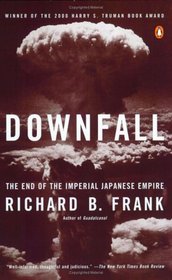This is an important book for those interested in World War II. It describes the fall of the Japanese Empire in great detail. From the heavy casualties U.S. forces suffered on Okinawa and Iwo Jima to the projected casualties for the invasion of Japan which made Okinawa and look like small skirmishes.
The author uses the breaking of the Japanese codes---Magic and Ultra---to good use, showing how the Japanese military was "proudly" planning the death of tens of millions of Japanese, if not the entire Japanese nation. He also makes the case as to why the U.S. allowed the Japanese emperor to remain in place, if not "in power." People often forget that the Japanese had almost two million men in uniform stationed throughout China, southeast Asia and the large islands of the southern Pacific. Just in Rabaul, which had been bypassed, there were 100,000 soldiers. An invasions of Japan was estimated to cost over one million American casualties. How many casualties would the U.S., British, and Chines forces take in subduing the Japanese military in the rest of Asia?
It is estimated that 100,000 Chinese citizens per month were dying due to the Japanese occupation. Not mentioned in this book is the fact that populations of Asians "liberated" by the Japanese from European control who volunteered to serve in labor battalions supporting the Japanese, died by the hundreds of thousands due to Japanese mistreatment. Also not mentioned in this book is the fact that after the bombing of Japan by the Doolittle Raiders in 1942, the Japanese brutally killed 250,000 Chinese civilians in the provinces where some of the American air crews bailed out.
A blockade of Japan would have resulted in millions of Japanese civilians dying of starvation as their food supply was already low and the rice crops had failed due to poor weather. Only a shipment of over 800,000 tons of food from the U.S. saved those people. Meanwhile, the Japanese had already sized 20-25 percent of the Korean rice crop to feed there own people, while being perfectly content to let the Koreans stave to death. This doesn't even include the tens of thousands of Korean women---and women of other nations---forced into Japanese Army brothels.
The biggest crime, also not mentioned in the book is the organized plan of the Japanese in the post-war years to make the U.S. look "Evil," since we dropped the Atomic bomb. This is akin to the post-Civil War effort of Southern Mythologists who spent generations rewriting the history of that conflict to make the Union appear the aggressors while Southerners were merely fighting for their "rights," with no mention of human slavery.
Sometimes, history is NOT written by the victors.
Yet, just after the war, 83 percent of Americans approved the dropping of the bombs. These were the servicemen and women who knew the terrible casualties they might have experienced, and the families of those men and women who knew they might never have been able to welcome their loved ones home.
The author uses the breaking of the Japanese codes---Magic and Ultra---to good use, showing how the Japanese military was "proudly" planning the death of tens of millions of Japanese, if not the entire Japanese nation. He also makes the case as to why the U.S. allowed the Japanese emperor to remain in place, if not "in power." People often forget that the Japanese had almost two million men in uniform stationed throughout China, southeast Asia and the large islands of the southern Pacific. Just in Rabaul, which had been bypassed, there were 100,000 soldiers. An invasions of Japan was estimated to cost over one million American casualties. How many casualties would the U.S., British, and Chines forces take in subduing the Japanese military in the rest of Asia?
It is estimated that 100,000 Chinese citizens per month were dying due to the Japanese occupation. Not mentioned in this book is the fact that populations of Asians "liberated" by the Japanese from European control who volunteered to serve in labor battalions supporting the Japanese, died by the hundreds of thousands due to Japanese mistreatment. Also not mentioned in this book is the fact that after the bombing of Japan by the Doolittle Raiders in 1942, the Japanese brutally killed 250,000 Chinese civilians in the provinces where some of the American air crews bailed out.
A blockade of Japan would have resulted in millions of Japanese civilians dying of starvation as their food supply was already low and the rice crops had failed due to poor weather. Only a shipment of over 800,000 tons of food from the U.S. saved those people. Meanwhile, the Japanese had already sized 20-25 percent of the Korean rice crop to feed there own people, while being perfectly content to let the Koreans stave to death. This doesn't even include the tens of thousands of Korean women---and women of other nations---forced into Japanese Army brothels.
The biggest crime, also not mentioned in the book is the organized plan of the Japanese in the post-war years to make the U.S. look "Evil," since we dropped the Atomic bomb. This is akin to the post-Civil War effort of Southern Mythologists who spent generations rewriting the history of that conflict to make the Union appear the aggressors while Southerners were merely fighting for their "rights," with no mention of human slavery.
Sometimes, history is NOT written by the victors.
Yet, just after the war, 83 percent of Americans approved the dropping of the bombs. These were the servicemen and women who knew the terrible casualties they might have experienced, and the families of those men and women who knew they might never have been able to welcome their loved ones home.




![header=[] body=[Get a free book credit right now by joining the club and listing 5 books you have and are willing to share with other members!] Help icon](/images/question.gif?v=90afaeb39)
